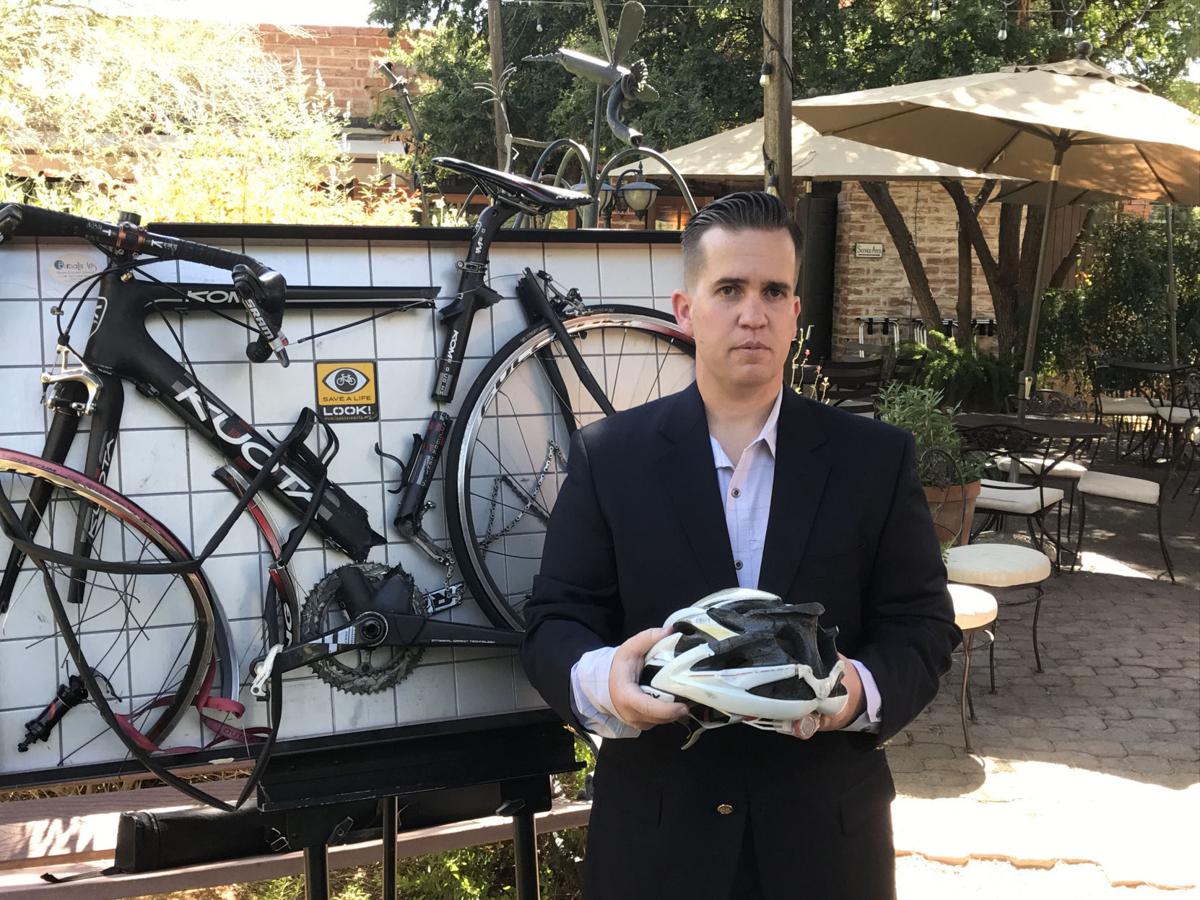In 2008, Tucson resident Brendan Lyons was, by his own description, an overweight emergency medical technician who dreamed of becoming a firefighter. That dream and the fitness it would require seemed out of reach until a friend introduced him to cycling.
“I ended up being pretty decent on a bicycle and weight just started (coming off),” he said. “I lost about 75 pounds. In 2009, I ended up attributing the bicycle to getting on full-time as a firefighter.”
Shortly after achieving that career goal, Lyons increased his cycling regimen and started training for El Tour de Tucson. It was during his preparation for that event that Lyons realized his newfound hobby could be dangerous.
“A car pulled out on the street from an apartment complex, and I’m in the bike lane,” he said. “I go head over handlebars, tear up my chin. The car took off.”
That hit-and-run accident was just the beginning. Over the next two years, Lyons was a first responder to several crashes involving bikes and motor vehicles, including a few that resulted in fatalities.
As a cyclist, Lyons ended up in the hospital in 2011 after colliding with a car that turned in front of him as it turned into a convenience store.
Having been affected both personally and professionally, Lyons felt compelled to try to improve bike safety in Arizona. That’s when he reached out to Look! Save a Life, a nonprofit founded in Idaho that aims to “foster an environment of safety for all who utilize our public byways.”
“These incidents happen all too often in my community,” said Lyons, who established a chapter of Look! Save a Life in Tucson. “I wanted to create awareness and education, so instead of starting my own nonprofit, I joined them and we became a national organization in 2012.”
Lyons says he was attracted to the organization because it holds both cyclists and motorists responsible for maintaining safe roadways.
“I think that safety is everyone’s responsibility,” Lyons said.
“It’s not a one-sided attack on motorists to pay attention. It’s also the incompetence of the cyclist, too.”
Lyons urges fellow cyclists to do everything they can to protect themselves, including never riding against traffic and always wearing a helmet.
He believes his helmet saved his life in his third, and most-devastating, crash in October 2013. Lyons and his girlfriend were out on a morning ride when a distracted driver traveling 45 mph struck them from behind.
“I don’t remember anything.” Lyons said. “What I do remember is days later. I remember awakening in a hospital bed in excruciating pain. I remember a cornucopia of wires, tubes, electrodes and multiple IV lines extending from my body.”
Lyons spent a month in the hospital with several fractured vertebrae, a fractured pelvis and a traumatic brain injury. Despite the severity of his injuries, Lyons acknowledges things might have been worse had he not been wearing a helmet.
“My helmet is pretty crushed in, but had I not been wearing that, who knows?” he asked. “I’m lucky to be alive.”
Other cyclists in Arizona have not been so lucky. Of U.S. cities with populations of more than 500,000 people, Tucson had the second-highest number of cyclist fatalities per million people in 2015 (7.52). Phoenix (5.12 fatalities per million people) ranked fourth, according to the most recent report from the National Highway Traffic Safety Administration.
A 2016 study by Australian statisticians Jake Olivier and Prudence Creighton concluded that helmet use reduces a cyclist’s chances of suffering a head injury by 51 percent and reduces the chance of fatal head injuries by 65 percent.
Despite the safety benefits, adult bicyclists are not required to wear helmets anywhere in the United States. In 21 states and the District of Columbia, there are laws requiring young riders to wear helmets, but the age mandate varies by state from as low as 11 years old to as high as 17.
Arizona law currently does not mandate helmets for cyclists of any age.
In 2014, state Sen. Steve Farley, D-Tucson, and a group of other lawmakers introduced legislation that would have required cyclists under the age of 18 to wear helmets. The bill died.
“All these bills that I have been putting in place over the years to improve bike safety, to improve pedestrian safety, to improve driver safety, they generally don’t get heard because it’s hard for a Democrat to get a bill passed in this place,” Farley said of the Arizona Legislature.
“I think this is as nonpartisan (of an) issue as you can get, keeping our transportation system safe for everybody, and it’s sad that some may inject partisanship into this process.”
Republican Sen. Karen Fann, vice chairman of the Senate Transportation and Technology Committee, says that helmet laws for bicyclists haven’t been passed because Arizona’s conservative legislature prefers to have fewer rules on the books, putting more personal responsibility on people.
While there is no state law requiring helmets for young riders, Tucson, Sierra Vista and Yuma have city ordinances requiring bicyclists under the age of 18 to wear a helmet. Pima County, where Tucson is located, also requires helmets for riders under 18.
Despite having faced strong opposition at the state level, Farley has faith Arizona will eventually get a law passed to protect young riders.
“I think at some point, just like we have booster-seat laws now, which took a long time to get here, I think we will have mandatory helmet laws as well for kids,” Farley said.
Until that day comes, organizations like Look! Save a Life and local first responders have been proactively educating young cyclists on the importance of bike safety.





